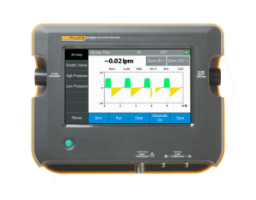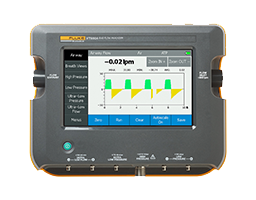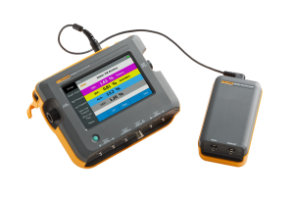By: Gerald Zion, BS, MS, CBET
Marketing Manager
Fluke Biomedical, a division of Fluke Electronics
Ventilators, aspirators, insufflators, gauges, flowmeters, calibration syringes, medical gas and vacuum outlets, surgical wound and chest suctioning devices, each of these exert a positive or negative pressure and create a positive or negative flow of gases (including room air). How many of these devices reside in your inventory, and need to be tested? How frequently must these devices be tested? What are you doing to make test documentation, troubleshooting, and repair quick, easy, and cost-effective? If you haven’t considered these questions in light of the current JCAHO guidelines and the expectations of the clinicians (doctors, nurses, and therapists) in your hospital you should. Documentation of performance test results and statistical trending of failuresfound is at the heart of justifying appropriate testing intervals (preventive maintenance frequency). Ensuring the performance of the devices against their manufacturer’s specifications, and even more important, ensuring proper functioning of these devices under conditions simulating real-life use improves the clinician’s ability to deliver high quality patient care.
Another important consideration is the impact to your budget dollar in terms of the acquisition and per-use cost of the test equipment necessary to properly evaluate performance and functionality. What is the impact to the hospital’s capital medical budget dollar in determining highly reliable devices versus those of lower reliability? What is the impact to your test-equipment budget?
Are you responsible for the management of these critical medical devices that control pressure and/or flow?
These are just a few of the categories. How many of each of these categories are in your inventory? How many items in each category? How frequently do your policies state that these items must be inspected? How long does it take to set up and perform the testing required? What test equipment will you use? How does that test equipment help you quickly capture the measurement data (information crucial to substantiating your decisions about frequency of inspection and perhaps even elements of that inspection). How does that test equipment allow test data to be stored (e.g. hard copy or electronic format)? A gas-flow analyzer capable of measuring pressure, flow, and oxygen concentration with pressure and flow ranges that allow all of the variety of medical devices listed above to be tested would provide the best value for the dollar invested, since it could be deployed across the range of devices, and would be used all year long. Here’s how I justified the purchase of such a device for the biomed shop in the first hospital in which I worked.
Early in the development of specialized test tools for the biomedical technician, we depended upon a set of individual pressure gauges and flowmeters that we had set up on a special bench specifically designed for gas flow device testing. These gauges and flowmeters, when purchased to meet the range and accuracy requirements, were not inexpensive. We also ran into the problem of not having the correct range or accuracy required to match the manufacturer’s specifications of new devices added to the inventory, and so we would have to expand the bench.
Another problem was that the bench could not be moved and still ensure the gauge and flowmeter accuracy, because the flowmeters had to be used on an absolutely level and plumb surface. This required us to bring the devices to the special bench rather than be able to perform inspections where the devices where stored (Respiratory Care storage spaces, OR storage spaces, or Central Supply/SPD). So we went shopping for a better solution. If we could find a test equipment solution that was capable of the wide range of pressures and flows necessary to complete testing of all the medical gas devices in our inventory, and whose total footprint could be kept small enough to fit in an equipment cart, then we believed we could perform the testing where the devices were stored. Batch inspections could be set-up on an assembly-line-like process. We needed portability, versatility, and economy. We found the RT-200™ (then made by Timeter, now owned by Allied Healthcare. This unit is no longer manufactured).
The RT-200 was the only such pressure and flow test device available at the time that met all these criteria. It had several inlet and outlet ports for measuring flow and pressure of gases. It also had several functions, some for high-range flow, and some for low-range flow. It had functions for high-range pressure and low-range pressure. The unit was expensive enough that, while we needed something to make our inspections NIST traceable, we also needed to spread that acquisition cost (as well as the cost of annual calibrations) across more devices.
The RT-200 also had limitations. It could measure flow in only one direction at a time. This did not allow the substantial time savings required for ventilator performance testing. It could not provide a graphical print-out of the measured data. Even obtaining a text/numeric-only printout was not easy. The acquisition cost at the time was about $2,500.00. If ventilators were to have been the only devices we used it for, and we had only 12 ventilators, our cost per device tested would have been $200.00 per inspection. By spreading the acquisition cost across more devices, for example 120 devices, our cost per inspection dropped to $20.00. Our break-even point would have been reached much more quickly and our utilization of the RT-200 would have been much more frequent, making our learning curve shorter and our expertise with the test device greater. We met our need with RT-200. That is until we purchased our first Servo 900C™ ventilator. Suddenly we could not evaluate performance at 120 breaths per minute (the maximum breath rate delivered by the Servo 900C).
Today, there is an opportunity to select test equipment for gas pressure and flow producing devices that is even more capable than RT-200. Bio-Tek™ (now Fluke Biomedical a division of Fluke Electronics Corporation) launched the VT Plus™ in 2000 as a replacement for its very reliable VT1™ and VT2™ ventilator testers. The VT Plus was a candidate for RT-200 replacement as well. VT Plus added the capability of an integrated large graphical display, easy one-button graphical and/or text/numeric printing, a special PC software application (that allowed the graphical and/or text/numeric data to be stored as an electronic file, as well as expanding the number of printers with which it was compatible). The pressure and flow ranges were broad enough to allow for uni and bidirectional flow, with or without breath detection. This allowed for continuous flow devices to be tested as well as ventilators of all kinds. The bidirectional flow capability allowed it to be connected to a ventilator at the patient breathing circuit y-piece and allowed collection of all ventilator parameters at the same time, thus speeding ventilator performance testing. Today, with the latest firmware (ver. 1.08.06 and higher) even HFOV (high frequency oscillatory ventilators) can be analyzed at the patient breathing circuit y-piece to ensure that pressure and flow delivery meet manufacturers’ specifications at ventilator frequency greater than 15 Hz, and the VT PLUS HF allows the use of the full RT-200 command set.
To determine whether the VT PLUS HF can be used to evaluate a gas flow device, simply compare the manufacturer’s specifications for the device against the specifications for gas pressure and flow ranges of the VT PLUS HF. If it is within the range, VT PLUS HF can and should be used. To assess the impact of this on budget dollars, let’s go back to the cost-per-use calculation we did earlier:
VT PLUS HF’s US list price is $8315. When the ACCU LUNG portable precision test lung is added (for ventilator performance testing), the combination price is $9710. If it is only used for ventilator testing and your hospital’s fleet of ventilators is 10 devices, then the VT PLUS HF acquisition costs amortized across the inventory of ventilators is $485.50 per ventilator (assuming that ventilator performance is only evaluated twice per year). This calculation also assumes that the VT PLUS HF useful life is equivalent to the useful life of the ventilators. Standard useful life should be about 5 to 7 years, but consult with your accounting department as to the applied life expectancy of medical devices in your hospital. The table below shows how the cost per use decreases when the VT PLUS HF is deployed across a larger fleet of gas flow devices
| Number of Gas Flow Devices in Fleet | Frequency of Inspection (Average) | Average Annual Number of Inspection Uses | Cost per Use ($8315 VT PLUS HF) | Cost per Use ($9710 VT Plus HF with ACCU LUNG) |
| 10 | 2 | 20 | $414.75 | $ 485.50 |
| 100 | 2 | 200 | $ 41.75 | $ 48.55 |
| 500 | 1,5 | 750 | $ 11.08 | $ 12.94 |
The table above assumes that preventive maintenance (performance evaluation) is the only use, but if the VT PLUS HF were also used in troubleshooting for repairs, the uses per year would increase and the cost per use would decrease. With such utilization, the VT PLUS HF would not sit on the shelf awaiting a quarterly or semi-annual ventilator inspection round, but find itself used every day. Think about how much shorter the learning curve would be for a device used every day versus one used once every 4 to 6 months. Think about how much more efficient testing would be, since the users would know how to use the test equipment. Each of these has an impact to the cost of operating your biomedical engineering or clinical engineering department, and as a support services cost, an impact on the profitability of your hospital.
But the savings impacts don’t stop there. Printing or saving the graphical electronic files, even if your inspection is a pass-fail (either the unit met its manufacturer’s specifications or it did not) enhances your ability to substantiate your decisions on frequency of inspection and criteria for inspection in accordance with JCAHO guidelines.
I took RT-200 to the location of device storage, you can take VT PLUS HF and your laptop, or VT PLUS HF and an HP or Epson graphic and text printer. By setting up an assembly-line-like process, you can meet your criteria for percent preventive maintenance inspections completed in any particular inspection cycle.
Some additional features supporting such use include the VT PLUS HF on-board barometer that ensures the accuracy of the calculated values in displays, and printouts.
Need more value out of that test equipment dollar for gas flow and pressure testing equipment? Take another look at VT PLUS HF. Do the math.
- Medical Gas Outlets
- Pressure gauges
- Flowmeters
- Suction devices
- Tracheal suctioning
- Suction/Vacuum regulators (e.g. Ohmeda Intermittent Suction Regulators)
- Aspirators
- Wound/Chest/Abdominal Suctioning
- Vaccum curettage devices
- Intermittent Suction Pumps (including thermotic designs)
- Tracheal suctioning
- Surgical devices o Laparoscopic insufflators
- Tourniquets
- Electrosurgery Units with Argon gas flow (pump performance)
- Patient Monitors
- NIBP pumps
- ETCO2 sample pumps
- Ventilators (including anesthesia ventilators and anesthesia machines)
- CMV (conventional mechanical ventilation)
- HFCMV (high frequency conventional mechanical ventilation)
- HFOV (high frequency oscillatory ventilation)


